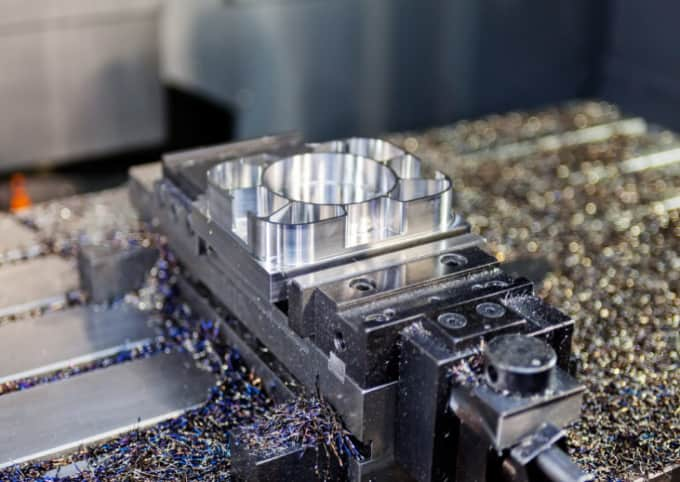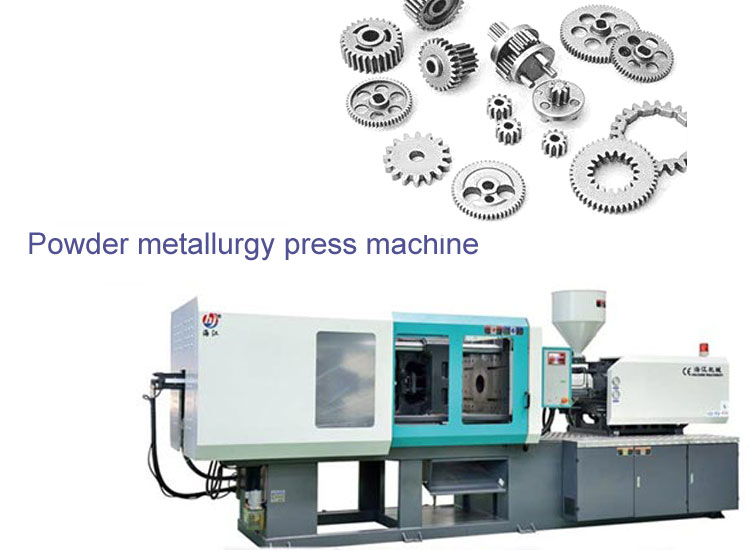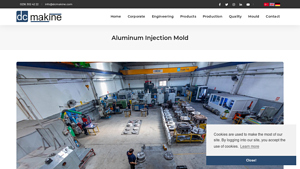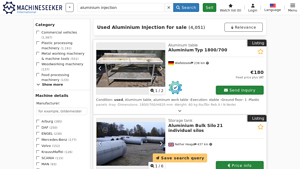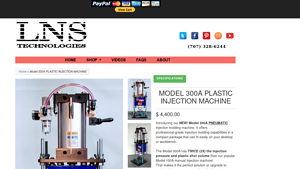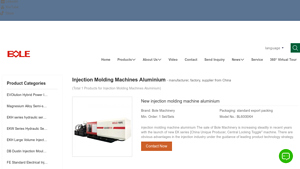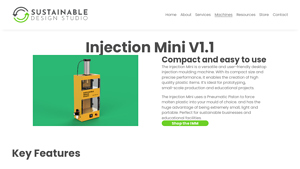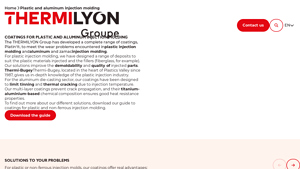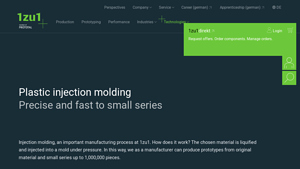Aluminium Injection Moulding Machine Guide: Type, Cost, Top List…
Introduction: Navigating the Global Market for aluminium injection moulding machine
Aluminium injection moulding machines are increasingly essential for manufacturers seeking lightweight, durable components while navigating the complexities of global supply chains. However, sourcing the right machine can be daunting, especially for international B2B buyers from regions like Africa, South America, the Middle East, and Europe. This guide aims to demystify the process of selecting aluminium injection moulding machines by exploring various types, applications, and the critical factors for supplier vetting.
From high-pressure to low-pressure injection systems, each machine offers unique benefits tailored to specific production needs. We will delve into the nuances of cost implications, maintenance requirements, and the latest technological advancements, empowering buyers to make informed decisions. The guide also highlights the importance of understanding local market dynamics and regulatory considerations, particularly for buyers in emerging markets like Vietnam and Brazil, where manufacturing practices are rapidly evolving.
By providing a comprehensive overview of the aluminium injection moulding landscape, this guide equips decision-makers with the insights necessary to enhance their procurement strategies and ensure a competitive edge in their respective industries. Whether you are an automotive manufacturer or an agricultural equipment supplier, this resource is designed to facilitate your journey toward successful sourcing and production optimization.
Understanding aluminium injection moulding machine Types and Variations
| Type Name | Key Distinguishing Features | Primary B2B Applications | Brief Pros & Cons for Buyers |
|---|---|---|---|
| High Pressure Injection Molding | Utilizes high pressure to inject molten aluminum into molds; fast production cycles. | Automotive parts, consumer electronics | Pros: High efficiency, excellent surface finish. Cons: Higher initial investment. |
| Low Pressure Injection Molding | Employs low pressure for a gentler fill; ideal for larger parts with complex geometries. | Aerospace components, large automotive parts | Pros: Reduces gas porosity, better for thick-walled parts. Cons: Slower cycle times. |
| Cold Chamber Injection Molding | Separate furnace for melting aluminum; minimizes exposure to air. | Heavy machinery, automotive applications | Pros: Suitable for high-temperature alloys, better control of metal quality. Cons: More complex setup. |
| Hot Chamber Injection Molding | Integrated furnace; ideal for low melting point alloys like Zamak. | Small parts, high-volume production | Pros: Faster cycle times, lower operational costs. Cons: Limited to alloys with lower melting points. |
| Die Casting Machines | General term encompassing both high and low pressure; versatile for various applications. | General manufacturing, custom parts | Pros: Flexibility in design, high precision. Cons: Requires skilled labor for setup and maintenance. |
What are the Characteristics of High Pressure Injection Molding Machines?
High pressure injection molding machines are designed to inject molten aluminum into molds at high speeds and pressures. This method is particularly suited for producing intricate and high-quality components, making it the preferred choice in the automotive and consumer electronics sectors. Buyers should consider the initial investment and operational costs, as these machines offer rapid production cycles but require a significant upfront expenditure.
How Does Low Pressure Injection Molding Differ?
Low pressure injection molding operates under gentler conditions, making it ideal for larger parts with complex geometries that require careful filling to avoid defects. This method is often utilized in aerospace and automotive applications where part integrity is critical. While it reduces the risk of gas porosity, the slower cycle times can be a drawback for manufacturers focused on high-volume output.
What are the Benefits of Cold Chamber Injection Molding?
Cold chamber injection molding is characterized by its separate melting furnace, which minimizes the exposure of molten aluminum to air, enhancing the quality of the final product. This method is particularly suitable for heavy machinery and automotive applications where high-temperature alloys are used. Buyers should weigh the benefits of superior metal quality against the more complex setup and potentially higher maintenance costs.
When is Hot Chamber Injection Molding Appropriate?
Hot chamber injection molding is efficient for alloys with lower melting points, such as Zamak. This method features an integrated furnace that allows for faster production cycles, making it ideal for high-volume manufacturing of small parts. However, its limitation to lower melting point alloys can restrict its applicability for buyers looking to work with a broader range of materials.
Why Consider Die Casting Machines?
Die casting machines encompass both high and low pressure methods, offering versatility for various manufacturing needs. They are ideal for general manufacturing and custom parts due to their precision and flexibility in design. Buyers should consider the expertise required for setup and maintenance, as well as the potential for high-quality output across a diverse range of applications.
Key Industrial Applications of aluminium injection moulding machine
| Industry/Sector | Specific Application of aluminium injection moulding machine | Value/Benefit for the Business | Key Sourcing Considerations for this Application |
|---|---|---|---|
| Automotive | Production of lightweight engine components | Reduces vehicle weight, enhancing fuel efficiency and performance | Compliance with automotive standards, precision in design, and long-term durability |
| Electronics | Manufacturing of heat sinks and enclosures | Improved thermal management and product lifespan | High precision molds, rapid production capabilities, and corrosion resistance |
| Aerospace | Creation of structural components for aircraft | High strength-to-weight ratio for fuel efficiency | Strict adherence to safety standards, advanced material specifications, and traceability |
| Agricultural Machinery | Production of lightweight machinery parts | Increased efficiency and reduced operational costs | Customization capabilities, high-volume production, and resistance to environmental factors |
| Consumer Goods | Development of durable consumer product casings | Enhanced product appeal and longer lifespan | Versatility in design, rapid prototyping, and cost-effectiveness |
How is Aluminium Injection Moulding Used in the Automotive Sector?
In the automotive industry, aluminium injection moulding machines are crucial for producing lightweight engine components, transmission housings, and structural parts. The use of aluminium significantly reduces the overall weight of vehicles, which directly translates to improved fuel efficiency and better handling. International buyers, particularly from regions like Africa and South America, must ensure that the machines comply with stringent automotive standards and deliver precision in design to meet the rigorous demands of this sector.
What Role Does Aluminium Injection Moulding Play in Electronics Manufacturing?
Aluminium injection moulding is widely used in electronics for creating heat sinks, casings, and structural components. The excellent thermal conductivity of aluminium helps in effective heat dissipation, thereby enhancing the lifespan of electronic devices. Buyers from Europe and the Middle East should focus on sourcing machines that offer high precision and rapid production capabilities to keep up with the fast-paced electronics market, while also ensuring that the moulds have a strong resistance to corrosion.
How is Aluminium Injection Moulding Beneficial for the Aerospace Industry?
In aerospace manufacturing, aluminium injection moulding machines are employed to produce lightweight yet strong structural components. These components are essential for aircraft, as they contribute to overall fuel efficiency and performance. Buyers must consider sourcing machines that comply with rigorous safety and quality standards, ensuring that the materials used meet specific aerospace specifications, which are critical for maintaining airworthiness.
What Advantages Does Aluminium Injection Moulding Offer for Agricultural Machinery?
The agricultural machinery sector utilizes aluminium injection moulding for producing lightweight parts such as frames, housings, and components for equipment. The reduced weight leads to increased operational efficiency and lower fuel consumption. International buyers, especially those from developing regions, should look for machines that offer customization options and are capable of high-volume production to meet the growing demands of modern agriculture while ensuring durability against harsh environmental conditions.
How Does Aluminium Injection Moulding Enhance Consumer Goods Production?
Aluminium injection moulding is increasingly being used in the consumer goods sector for creating durable and aesthetically appealing product casings. This process allows for rapid prototyping and cost-effective production, making it ideal for fast-moving consumer goods. Buyers from diverse markets should prioritize sourcing versatile moulding machines that can adapt to various designs while maintaining high quality and production speed, ensuring their products stand out in a competitive marketplace.
3 Common User Pain Points for ‘aluminium injection moulding machine’ & Their Solutions
Scenario 1: Difficulty in Achieving Precision and Quality in Production
The Problem:
B2B buyers in the manufacturing sector often face challenges related to precision and quality when using aluminium injection moulding machines. With the growing demand for lightweight yet durable components, manufacturers find themselves struggling to maintain the required dimensional accuracy and surface finish. Problems such as warping, inconsistent wall thickness, and air pockets can arise during the injection process, leading to increased scrap rates and production delays. This not only affects profitability but also jeopardizes relationships with customers who expect high-quality products.
The Solution:
To mitigate these issues, buyers should prioritize investing in advanced aluminium injection moulding machines equipped with features like real-time monitoring systems and automated quality control. Conducting a thorough evaluation of machine specifications, including injection pressure, cooling time, and mold design, is critical. Collaborating with experienced suppliers who understand the intricacies of aluminium properties can also aid in selecting the right machine for specific applications.
Additionally, implementing a robust training program for operators is essential to ensure they understand the machine’s capabilities and limitations. Utilizing computer-aided design (CAD) software can enhance mold design precision, while regular maintenance of machines will prevent unexpected downtimes and further enhance production quality. Establishing a continuous feedback loop with the production team can help identify and resolve quality issues promptly.
Scenario 2: High Operating Costs Due to Inefficient Machinery
The Problem:
In regions like Africa and South America, where operational costs can significantly impact profitability, B2B buyers often encounter the challenge of high energy consumption and maintenance expenses associated with older or inefficient aluminium injection moulding machines. These machines may require frequent repairs and consume more power, leading to inflated production costs and reduced competitiveness in the market.
The Solution:
Investing in energy-efficient aluminium injection moulding machines can provide significant long-term savings. Buyers should look for machines that feature energy recovery systems and advanced hydraulic systems, which minimize energy consumption during operation. Conducting a cost-benefit analysis before purchasing or upgrading machinery can help identify models that offer the best return on investment.
Additionally, retrofitting existing machines with energy-efficient components can be a cost-effective solution for enhancing performance without the need for complete replacement. Establishing a scheduled maintenance routine can also reduce unexpected breakdowns and prolong the lifespan of the equipment. Engaging with suppliers who offer comprehensive after-sales support and training can ensure that operators are fully equipped to use the machines efficiently, further lowering operational costs.
Scenario 3: Complexity in Customization and Scalability of Production
The Problem:
B2B buyers frequently face difficulties when it comes to customizing aluminium components to meet diverse client specifications. As market demands shift towards more personalized solutions, the inability to quickly adapt production processes can lead to lost opportunities and dissatisfied customers. This is particularly problematic for businesses in rapidly evolving sectors such as automotive and consumer electronics, where customization and scalability are crucial.
The Solution:
To effectively address these challenges, buyers should opt for aluminium injection moulding machines that offer flexible and modular designs. Machines with interchangeable molds allow for rapid changes in production setups, enabling manufacturers to respond swiftly to varying customer demands. It is also beneficial to work with suppliers who can provide tailored solutions, including custom mold designs that cater to specific product requirements.
Investing in automation technology can further enhance scalability. Automated systems can streamline the production process, reducing lead times while maintaining high-quality standards. Additionally, leveraging data analytics to monitor production metrics can help identify trends and optimize manufacturing processes, ensuring that businesses can scale operations up or down as needed. Building strong partnerships with suppliers who understand the importance of customization can provide a competitive edge in the marketplace.
Strategic Material Selection Guide for aluminium injection moulding machine
What Materials Are Commonly Used in Aluminium Injection Moulding Machines?
When selecting materials for aluminium injection moulding machines, it’s crucial to consider their properties, advantages, and limitations. This section analyzes several materials commonly used in the construction and operation of these machines, focusing on their relevance to B2B buyers, especially in diverse markets such as Africa, South America, the Middle East, and Europe.
What Are the Key Properties of Steel in Aluminium Injection Moulding Machines?
Steel is a prevalent choice for the construction of injection moulds due to its excellent mechanical properties and durability. It typically offers high temperature and pressure ratings, making it suitable for high-pressure die casting processes. Steel’s corrosion resistance can be enhanced through various treatments, ensuring longevity in harsh operational environments.
Pros: Steel moulds are highly durable and can withstand repeated use, which is essential for high-volume production. They also provide excellent dimensional stability, ensuring that the end products maintain their specifications.
Cons: The initial cost of steel moulds can be high, and their manufacturing complexity may lead to longer lead times. Additionally, they can be heavy, which might affect the overall machinery weight and handling.
Impact on Application: Steel is compatible with various aluminium alloys, making it versatile for different applications, including automotive and industrial components.
Considerations for International Buyers: Buyers should ensure compliance with international standards such as ASTM A36 or DIN 1.4401 for steel quality. Local regulations regarding material sourcing and environmental impact should also be considered.
How Does Aluminum Compare as a Material in Injection Moulding?
Aluminum itself is often used in the construction of injection moulding machines, particularly in components that require lightweight properties and good thermal conductivity. Aluminum’s resistance to corrosion and its ability to dissipate heat quickly are significant advantages.
Pros: The lightweight nature of aluminum reduces the overall weight of the machinery, facilitating easier transport and installation. Its thermal conductivity allows for efficient heat management during the injection process.
Cons: While aluminum is resistant to corrosion, it may not be as durable as steel under extreme conditions. It can also be more expensive than other materials, depending on the alloy used.
Impact on Application: Aluminum is particularly suitable for applications requiring lightweight components, such as in the automotive sector, where fuel efficiency is critical.
Considerations for International Buyers: Compliance with material standards such as ASTM B221 for aluminum extrusions is essential. Buyers should also consider local preferences for aluminum grades and alloys.
What Role Does Copper Play in Aluminium Injection Moulding Machines?
Copper is sometimes used in components that require excellent thermal and electrical conductivity, such as heating elements or cooling systems within the injection moulding machine.
Pros: Copper’s high thermal conductivity ensures efficient heat transfer, which is crucial for maintaining optimal temperatures during the injection process.
Cons: Copper is generally more expensive than both steel and aluminum and can be prone to corrosion if not properly treated.
Impact on Application: Copper is ideal for applications requiring rapid heating and cooling, such as in high-speed production environments.
Considerations for International Buyers: Buyers should ensure that copper components meet standards such as ASTM B170 for copper alloys. Additionally, understanding the local market for copper pricing and availability is vital.
How Do Plastics Factor into Aluminium Injection Moulding Machines?
Plastics, particularly high-performance thermoplastics, are increasingly used in components of aluminium injection moulding machines, especially in non-structural parts.
Pros: Plastics are lightweight, resistant to corrosion, and can be molded into complex shapes, making them ideal for various applications.
Cons: Plastics may not withstand high temperatures and pressures as effectively as metals, limiting their use in critical areas of the machine.
Impact on Application: Plastics can be used in auxiliary components, such as covers and housings, where metal strength is not as critical.
Considerations for International Buyers: Compliance with standards such as ASTM D638 for plastic materials is essential. Buyers should also consider the environmental impact of plastic use and disposal in their regions.
Summary Table of Material Selection for Aluminium Injection Moulding Machines
| Material | Typical Use Case for aluminium injection moulding machine | Key Advantage | Key Disadvantage/Limitation | Relative Cost (Low/Med/High) |
|---|---|---|---|---|
| Steel | Mould construction for high-volume production | High durability and dimensional stability | High initial cost and manufacturing complexity | High |
| Aluminum | Structural components and lightweight parts | Lightweight and excellent thermal conductivity | Less durable than steel under extreme conditions | Medium |
| Copper | Heating and cooling components | Excellent thermal conductivity | Higher cost and corrosion susceptibility | High |
| Plastics | Non-structural components like covers | Lightweight and corrosion-resistant | Limited temperature and pressure tolerance | Low |
This material selection guide provides actionable insights for international B2B buyers, helping them make informed decisions based on their specific operational needs and regional compliance requirements.
In-depth Look: Manufacturing Processes and Quality Assurance for aluminium injection moulding machine
Aluminium injection moulding is a sophisticated process that combines advanced manufacturing techniques with stringent quality assurance measures to produce high-quality components. Understanding these manufacturing processes and quality control protocols is essential for B2B buyers, particularly those in regions like Africa, South America, the Middle East, and Europe, where the demand for reliable and efficient machinery is growing.
What are the Main Stages of Manufacturing an Aluminium Injection Moulding Machine?
The manufacturing of aluminium injection moulding machines can be segmented into several critical stages: material preparation, forming, assembly, and finishing.
How is Material Prepared for Aluminium Injection Moulding?
Material preparation is the foundational step in the manufacturing process. High-quality aluminium alloys are selected based on their thermal and mechanical properties. The chosen alloys are then melted in a furnace, typically using a cold chamber or hot chamber system, depending on the application. In cold chamber machines, the molten aluminium is poured into the injection chamber, while hot chamber systems inject molten metal directly from the furnace. This choice significantly impacts the efficiency and quality of the final product.
What Forming Techniques are Used in Aluminium Injection Moulding?
Once the material is prepared, the next stage is forming. The molten aluminium is injected into a precisely engineered steel mold under high pressure. This process can be categorized into two main techniques: high-pressure injection and low-pressure injection. High-pressure injection is the most common, accounting for about 70% of the market, where molten aluminium is forced into the mold cavity using a piston mechanism. Low-pressure injection, on the other hand, utilizes controlled air pressure to fill the mold, often resulting in less porosity and superior surface finish. Each method has its advantages, and the choice depends on the specific application and required product characteristics.
How is the Assembly Process Conducted?
After forming, the components undergo assembly. This involves the careful integration of various machine parts, including the injection system, hydraulic systems, and control units. Precision in assembly is crucial to ensure that the machine operates smoothly and efficiently. Manufacturers often utilize automated assembly systems to enhance accuracy and reduce assembly time, which is vital for meeting production schedules.
What Finishing Processes are Essential for Aluminium Injection Moulding Machines?
The finishing stage encompasses surface treatment and quality checks. Common finishing processes include polishing, anodizing, and coating to enhance corrosion resistance and aesthetic appeal. Each of these treatments must comply with industry standards to ensure durability and performance.
What Quality Control Measures are Implemented in Aluminium Injection Moulding?
Quality control (QC) is paramount in the manufacturing of aluminium injection moulding machines. The goal is to ensure that every machine meets international and industry-specific standards, guaranteeing reliability and performance.
Which International Standards are Relevant for Aluminium Injection Moulding Machines?
Many manufacturers adhere to international standards such as ISO 9001, which outlines quality management principles that organizations must follow. Additionally, certifications like CE mark for compliance with European health, safety, and environmental protection standards are crucial for machines sold in Europe. API standards may also be relevant for machines intended for the oil and gas sector, emphasizing the importance of industry-specific certifications.
What are the Key QC Checkpoints in the Manufacturing Process?
Quality control checkpoints are strategically placed throughout the manufacturing process. These include:
- Incoming Quality Control (IQC): Assessment of raw materials to ensure they meet specified standards before production begins.
- In-Process Quality Control (IPQC): Continuous monitoring during manufacturing to catch any deviations from quality standards early.
- Final Quality Control (FQC): Comprehensive testing of the finished product to ensure it meets design specifications and regulatory requirements.
What Common Testing Methods are Used for Quality Assurance?
Testing methods vary but often include dimensional inspections, mechanical property testing, and non-destructive testing (NDT) techniques such as ultrasonic or X-ray testing. These methods help identify defects such as porosity or structural weaknesses, ensuring that the final product is robust and reliable.
How Can B2B Buyers Verify Supplier Quality Control Practices?
B2B buyers must conduct due diligence when selecting suppliers for aluminium injection moulding machines. Here are several ways to verify QC practices:
- Audits: Regular audits of suppliers’ facilities can provide insights into their manufacturing processes and adherence to quality standards. Buyers should request audit reports to assess compliance.
- Quality Reports: Suppliers should provide detailed quality reports that outline their testing methods, results, and corrective actions taken in case of non-conformance.
- Third-party Inspections: Engaging third-party inspection agencies can offer an impartial review of the manufacturing process and product quality. This is particularly important for international buyers who may face challenges in evaluating suppliers directly.
What are the Quality Control Nuances for International B2B Buyers?
For international B2B buyers, particularly from regions like Africa and South America, understanding the quality control nuances is critical. Buyers should be aware of the differences in manufacturing standards and practices across regions. Establishing clear communication with suppliers regarding quality expectations and certifications can help mitigate risks associated with product quality. Additionally, understanding local regulations and compliance requirements is essential to ensure that the machinery meets the necessary standards for operation in different markets.
In conclusion, a comprehensive understanding of the manufacturing processes and quality assurance practices for aluminium injection moulding machines is vital for B2B buyers. By focusing on material preparation, forming techniques, assembly, and finishing, alongside robust quality control measures, buyers can make informed decisions that align with their operational needs and quality expectations.
Practical Sourcing Guide: A Step-by-Step Checklist for ‘aluminium injection moulding machine’
Introduction
This guide serves as a practical checklist for B2B buyers seeking to procure aluminium injection moulding machines. With the increasing demand for lightweight and durable components across various industries, selecting the right machine is crucial for operational efficiency and product quality. This checklist will help you navigate the procurement process systematically, ensuring you make informed decisions.
Step 1: Define Your Technical Specifications
Establishing clear technical specifications is the foundation of sourcing an aluminium injection moulding machine. Consider factors such as the type of aluminium alloys you will be using, the required production volume, and the complexity of the parts you intend to manufacture.
– Key Considerations:
– Maximum injection pressure and clamping force needed for your projects.
– The type of injection method: high pressure or low pressure, depending on your product design.
Step 2: Research Industry Standards and Regulations
Understanding the relevant industry standards and regulations is vital to ensure compliance and quality assurance. Different regions may have specific certifications for machinery, especially in sectors like automotive or aerospace.
– What to Look For:
– ISO certifications or other relevant industry standards.
– Compliance with local safety and environmental regulations.
Step 3: Evaluate Potential Suppliers
Before committing to a supplier, it’s essential to conduct thorough evaluations. Request company profiles, case studies, and references from buyers in similar industries or geographical regions to assess their credibility and experience.
– Assessment Criteria:
– Track record of successful installations and customer satisfaction.
– Financial stability and longevity in the market.
Step 4: Request Detailed Quotations
Obtaining detailed quotations from shortlisted suppliers allows for better comparison and understanding of costs involved. Ensure that the quotes include machine specifications, warranty terms, and after-sales services.
– Important Aspects:
– Breakdown of initial costs versus ongoing operational costs.
– Consideration of additional costs such as installation, training, and maintenance.
Step 5: Consider After-Sales Support and Maintenance
After-sales support is critical in ensuring the longevity and efficiency of your aluminium injection moulding machine. Evaluate the level of technical support and maintenance services offered by the supplier.
– Key Elements to Verify:
– Availability of spare parts and service technicians in your region.
– Training programs for your staff on machine operation and maintenance.
Step 6: Visit Manufacturing Facilities
If possible, visiting the manufacturing facilities of potential suppliers can provide invaluable insights into their operations. This allows you to assess their quality control processes and the technology they employ.
– What to Observe:
– The cleanliness and organization of the production area.
– The use of advanced technologies and skilled workforce.
Step 7: Finalize the Contract Terms
Once you have selected a supplier, it’s time to finalize the contract terms. Ensure that all agreed-upon specifications, timelines, and payment terms are clearly outlined to avoid misunderstandings.
– Contractual Considerations:
– Clauses on warranties, liability, and dispute resolution.
– Terms for cancellation or modification of the order.
By following this checklist, B2B buyers can streamline their procurement process, ensuring they select an aluminium injection moulding machine that meets their operational needs while also fostering a strong supplier relationship.
Comprehensive Cost and Pricing Analysis for aluminium injection moulding machine Sourcing
What Are the Key Cost Components for Aluminium Injection Moulding Machines?
When sourcing aluminium injection moulding machines, understanding the cost structure is paramount. The primary cost components include materials, labor, manufacturing overhead, tooling, quality control (QC), logistics, and profit margin.
-
Materials: The quality of aluminium alloys can significantly influence costs. High-grade alloys may incur higher upfront costs but offer better performance and longevity, which can reduce the total cost of ownership over time.
-
Labor: Labor costs vary by region and skill level. In countries with lower labor costs, like some parts of Africa and South America, buyers may find competitive pricing. However, skilled labor for machine operation and maintenance is crucial for efficiency.
-
Manufacturing Overhead: This includes utilities, equipment maintenance, and factory management expenses. Depending on the supplier’s operational efficiency, these costs can vary, affecting the final pricing.
-
Tooling: Tooling represents a significant investment in the production process. Custom molds tailored for specific designs can increase costs due to the intricate design and manufacturing processes involved.
-
Quality Control: Ensuring product quality through rigorous QC processes can add to costs but is essential for preventing defects and ensuring compliance with international standards.
-
Logistics: Transportation costs can vary based on distance, shipping methods, and tariffs. Buyers should consider the full logistics chain, especially when sourcing from international suppliers.
-
Margin: Suppliers will typically include a profit margin in their pricing. Understanding the average margins in the industry can help buyers gauge if a price is competitive.
How Do Price Influencers Affect Aluminium Injection Moulding Machine Costs?
Several factors influence pricing beyond the basic cost components.
-
Volume and Minimum Order Quantity (MOQ): Larger orders often lead to reduced per-unit costs. Buyers should negotiate MOQs that align with their production needs to optimize pricing.
-
Specifications and Customization: Highly customized machines or those with advanced features will typically cost more. Clearly defining requirements upfront can help manage expectations and pricing.
-
Materials and Quality Certifications: The choice of materials and necessary certifications (like ISO standards) can affect costs. Machines built with premium materials or those certified for specific industries may command higher prices.
-
Supplier Factors: The supplier’s reputation, location, and production capabilities can all influence pricing. Established suppliers with a track record of reliability might charge more but can offer peace of mind.
-
Incoterms: Understanding the shipping terms (e.g., FOB, CIF) is crucial, as they dictate who bears the costs and risks during transit. This can significantly impact the total landed cost of the machinery.
What Negotiation Tips Can Help Buyers Optimize Costs?
Negotiating effectively can lead to substantial cost savings. Here are some strategies:
-
Understand Total Cost of Ownership (TCO): Beyond the purchase price, consider maintenance, operation, and eventual disposal costs. A higher upfront investment may lead to lower TCO if the machine is more efficient and durable.
-
Leverage Volume Discounts: If planning for future purchases, negotiate a discount based on projected volumes. Suppliers may be more willing to offer better pricing for assured future business.
-
Compare Multiple Quotes: Gathering quotes from several suppliers can provide leverage in negotiations. It allows buyers to identify competitive pricing and terms.
-
Focus on Long-Term Relationships: Building a long-term partnership with suppliers can lead to better pricing, priority service, and access to new technologies.
What Pricing Nuances Should International Buyers Be Aware Of?
International buyers, particularly from regions like Africa, South America, the Middle East, and Europe, should be aware of unique pricing nuances:
-
Currency Fluctuations: Currency exchange rates can significantly impact costs. It’s wise to negotiate prices in a stable currency or consider hedging against fluctuations.
-
Import Duties and Taxes: Understanding local import regulations and taxes can help buyers anticipate additional costs that may not be included in the initial quote.
-
Cultural Differences in Negotiation: Different regions have varying negotiation styles. Familiarizing oneself with local customs can facilitate smoother discussions and potentially better deals.
Disclaimer on Indicative Prices
Prices for aluminium injection moulding machines can vary widely based on the factors discussed. The information provided serves as a guideline, and potential buyers are encouraged to conduct thorough market research and engage directly with suppliers for the most accurate and current pricing.
Alternatives Analysis: Comparing aluminium injection moulding machine With Other Solutions
When considering the production of aluminum components, it is essential to evaluate various manufacturing methods that can achieve similar results. The choice of technology can significantly impact performance, costs, and overall efficiency. Below, we compare aluminum injection molding machines with two alternative solutions: sand casting and 3D printing for metal parts.
| Comparison Aspect | Aluminium Injection Moulding Machine | Sand Casting | 3D Printing for Metal Parts |
|---|---|---|---|
| Performance | High precision and repeatability | Moderate precision, suitable for large parts | Excellent for complex geometries, lower strength |
| Cost | Higher initial investment; lower per unit cost at scale | Lower initial investment; higher labor costs | High material costs; economical for low volumes |
| Ease of Implementation | Requires specialized machinery and training | Simple setup; requires molds | Requires advanced technology and training |
| Maintenance | Regular maintenance needed; complex machinery | Lower maintenance; simpler process | Requires careful handling and calibration |
| Best Use Case | Mass production of lightweight components | Large, less complex parts; prototypes | Custom parts, rapid prototyping, and small batches |
What Are the Pros and Cons of Sand Casting as an Alternative?
Sand casting is a traditional method that involves creating a mold from a mixture of sand and a binding agent. This process is particularly advantageous for producing large components or prototypes. Its lower initial investment makes it appealing for smaller manufacturers or projects with limited budgets. However, the precision of sand casting is generally lower than that of aluminum injection molding, which may lead to inconsistencies in final products. Additionally, sand casting can be labor-intensive, resulting in higher overall costs for large production runs.
How Does 3D Printing for Metal Parts Compare?
3D printing technology, particularly for metal parts, offers a revolutionary approach to manufacturing. It excels in producing complex geometries that would be challenging or impossible with traditional methods. The flexibility of design allows for rapid prototyping and customization, making it an attractive option for specialized projects. However, the costs associated with 3D printing can be prohibitive, especially for larger components, and the mechanical properties of printed parts may not match those produced through aluminum injection molding. This technology requires skilled operators and sophisticated equipment, which can complicate implementation.
Conclusion: How Can B2B Buyers Choose the Right Solution?
Selecting the right manufacturing method hinges on specific project requirements, including volume, complexity, and budget. Aluminum injection molding machines are ideal for high-volume production with consistent quality and precision. In contrast, sand casting may be suitable for larger, simpler components where cost is a primary concern. For projects requiring intricate designs and rapid turnaround, 3D printing may be the best choice, albeit at a higher cost. Buyers should assess their unique needs, including expected production volumes and required part specifications, to make an informed decision that aligns with their operational goals.
Essential Technical Properties and Trade Terminology for aluminium injection moulding machine
What Are the Essential Technical Properties of Aluminium Injection Moulding Machines?
When considering the procurement of aluminium injection moulding machines, understanding their technical properties is crucial. Here are several key specifications that B2B buyers should focus on:
What Material Grades Are Important in Aluminium Injection Moulding?
Material Grade refers to the specific type of aluminium alloy used in the manufacturing process. Common grades include 6061 and 6063, known for their excellent corrosion resistance and machinability. Selecting the right material grade is vital as it directly impacts the durability, strength, and thermal conductivity of the final products. For industries like automotive and aerospace, where performance and safety are paramount, choosing the appropriate material grade can make a significant difference in product reliability.
How Does Tolerance Affect Product Quality in Injection Moulding?
Tolerance is the allowable variation in the dimensions of the moulded parts. In aluminium injection moulding, tight tolerances (often within ±0.1 mm) are critical for parts that must fit together precisely. Understanding tolerance specifications helps ensure that parts meet design requirements and function correctly within assemblies. Poor tolerance can lead to increased production costs due to rework or scrap, emphasizing the importance of clear communication between suppliers and buyers.
What Is the Role of Cycle Time in Production Efficiency?
Cycle Time refers to the total time required to complete one cycle of the injection moulding process, from melting the aluminium to ejecting the finished part. Efficient cycle times are essential for maximizing productivity and reducing operational costs. In a competitive B2B environment, shorter cycle times can lead to higher output and profitability, making it crucial for buyers to inquire about the average cycle time of the machines they are considering.
Why Is Clamping Force a Critical Specification?
Clamping Force is the amount of pressure applied to keep the mould closed during the injection process. This force is critical for preventing defects such as flashing and ensuring the integrity of the final product. High clamping forces are necessary for complex mould designs or thicker parts. Buyers should ensure that the machine’s clamping force meets the requirements of their specific applications to avoid production issues.
What Trade Terminology Should B2B Buyers Know in Aluminium Injection Moulding?
Familiarity with industry jargon is essential for effective communication and negotiation in the B2B landscape. Here are some common terms:
What Does OEM Mean in the Context of Injection Moulding?
OEM stands for Original Equipment Manufacturer. In the context of aluminium injection moulding, it refers to companies that produce parts that are used in another company’s products. Understanding OEM relationships is crucial for buyers looking to source parts for larger assemblies, as it influences pricing, quality control, and supply chain dynamics.
How Is MOQ Relevant to Purchasing Decisions?
MOQ refers to Minimum Order Quantity. It represents the smallest quantity of a product that a supplier is willing to sell. Knowing the MOQ helps buyers manage inventory and budget effectively, particularly when dealing with custom moulds or specific alloy grades, which may require larger upfront investments.
What Is RFQ and Why Is It Important?
RFQ stands for Request for Quotation. It is a document issued by buyers to suppliers to solicit pricing for specific quantities of products. Issuing an RFQ is a crucial step in the procurement process, as it enables buyers to compare costs and terms from different suppliers, ensuring they make informed purchasing decisions.
How Do Incoterms Affect International Shipping?
Incoterms are international commercial terms that define the responsibilities of buyers and sellers in shipping goods. Understanding these terms is vital for B2B buyers engaged in international trade, as they outline who is responsible for shipping costs, insurance, and risk during transport. This knowledge helps buyers avoid unexpected costs and ensures smoother transactions.
By grasping these essential technical properties and trade terms, B2B buyers can make informed decisions when investing in aluminium injection moulding machines, ultimately leading to enhanced operational efficiency and product quality.
Navigating Market Dynamics and Sourcing Trends in the aluminium injection moulding machine Sector
What Are the Key Market Dynamics Affecting the Aluminium Injection Moulding Machine Sector?
The aluminium injection moulding machine sector is witnessing robust growth driven by several global factors. Notably, the rising demand for lightweight components in the automotive and aerospace industries is propelling the adoption of aluminium due to its strength-to-weight ratio. Additionally, the shift towards electric vehicles (EVs) is increasing the need for efficient manufacturing processes that can produce complex geometries, which aluminium injection moulding readily facilitates.
Emerging technologies such as automation and Industry 4.0 are transforming sourcing trends. International buyers, particularly from Africa, South America, the Middle East, and Europe, are increasingly looking for machines that integrate advanced data analytics and IoT capabilities. These technologies not only enhance operational efficiency but also improve product traceability and quality control. Furthermore, the market is seeing a surge in demand for cold chamber machines, which are preferred for aluminium casting due to their ability to handle high temperatures without damaging the pumping system.
The competitive landscape is also evolving, with an increasing emphasis on customization and rapid prototyping. Companies are investing in flexible manufacturing systems that allow for quick changes in production lines, catering to diverse client needs while optimizing costs. This trend underscores the importance of partnering with manufacturers that offer tailored solutions and robust after-sales support.
How Is Sustainability Shaping the Sourcing of Aluminium Injection Moulding Machines?
Sustainability has emerged as a critical factor in the sourcing of aluminium injection moulding machines. The environmental impact of manufacturing processes is under scrutiny, prompting businesses to prioritize ethical sourcing and green certifications. Buyers are increasingly seeking suppliers that demonstrate a commitment to sustainable practices, such as using recycled aluminium and minimizing waste during production.
In addition to environmental concerns, companies are focusing on ethical supply chains that promote fair labor practices and resource management. This shift is particularly relevant for international buyers from regions like Africa and South America, where transparency in sourcing is vital for maintaining brand reputation and consumer trust.
Certifications like ISO 14001 for environmental management and LEED for energy-efficient manufacturing are becoming essential in supplier evaluations. Companies that invest in eco-friendly technologies not only reduce their carbon footprint but also appeal to a growing base of environmentally conscious consumers. As a result, aligning procurement strategies with sustainability goals can enhance competitive advantage and open new market opportunities.
What Is the Historical Context of Aluminium Injection Moulding Machines?
The evolution of aluminium injection moulding machines traces back to the early 20th century when the die-casting process began gaining traction. Initially dominated by the steel and iron industries, aluminium’s lightweight and corrosion-resistant properties soon made it a preferred material for various applications. The introduction of high-pressure die casting methods significantly advanced production capabilities, allowing manufacturers to create intricate designs with precision.
As industries evolved, particularly automotive and aerospace, the demand for aluminium components surged, leading to innovations in injection moulding technologies. The development of cold chamber machines in the 1960s marked a significant milestone, enabling the production of high-quality aluminium parts under extreme temperatures. Today, the sector is characterized by continuous advancements in automation, material science, and process efficiency, setting the stage for further growth and innovation in the coming years.
Frequently Asked Questions (FAQs) for B2B Buyers of aluminium injection moulding machine
-
How do I choose the right aluminium injection moulding machine for my business needs?
Choosing the right aluminium injection moulding machine requires assessing several factors, including the types of products you intend to manufacture, the production volume, and your budget. Evaluate the machine’s specifications such as clamping force, injection speed, and chamber type (cold or hot). Additionally, consider the machine’s compatibility with your existing production line and the after-sales support offered by the supplier. Consulting with industry experts or conducting a pilot test can also provide valuable insights into the machine’s performance. -
What is the typical lead time for ordering an aluminium injection moulding machine?
The lead time for ordering an aluminium injection moulding machine can vary significantly based on the manufacturer, customization options, and current demand. Typically, standard machines may take anywhere from 4 to 12 weeks to manufacture and deliver. However, customized machines or those that require specific configurations may extend this timeline. It is advisable to discuss timelines with your supplier upfront and factor in additional time for installation and training. -
What are the common payment terms for international purchases of aluminium injection moulding machines?
Payment terms for international purchases often include options such as a deposit upfront (typically 30-50%) with the balance due upon completion or before shipment. Some suppliers may offer financing options or letters of credit to facilitate transactions. It’s essential to clarify payment methods, currency, and any applicable fees in advance. Additionally, ensure that you understand the implications of currency fluctuations when transacting internationally. -
What factors should I consider when vetting suppliers of aluminium injection moulding machines?
When vetting suppliers, consider their industry experience, reputation, and customer reviews. Look for certifications such as ISO standards, which indicate quality management practices. Request references from previous clients and inquire about their after-sales support and warranty policies. Additionally, assess the supplier’s ability to provide spare parts and technical assistance, which are crucial for maintaining machine performance and minimizing downtime. -
Can I customize the aluminium injection moulding machine according to my specifications?
Yes, many manufacturers offer customization options for aluminium injection moulding machines to meet specific production requirements. Customizations may include modifications to clamping force, injection speed, or mold design. Discuss your unique needs with the supplier, and ensure they can accommodate your specifications without compromising quality or delivery timelines. Be aware that custom machines may have longer lead times and potentially higher costs. -
What is the minimum order quantity (MOQ) for aluminium injection moulding machines?
The minimum order quantity (MOQ) for aluminium injection moulding machines varies by supplier and may depend on the machine type and customization level. Some suppliers may have a standard MOQ for bulk purchases, while others may be flexible for smaller orders. It’s advisable to communicate your needs clearly to the supplier and negotiate terms that align with your production plans and budget. -
What quality assurance measures should I expect when purchasing an aluminium injection moulding machine?
Reputable suppliers will implement rigorous quality assurance measures throughout the manufacturing process. This includes inspections at various stages, testing machine performance, and ensuring compliance with international standards. Request documentation of quality checks, certifications, and warranty terms before finalizing your purchase. Additionally, inquire about the supplier’s processes for addressing defects or issues post-delivery to ensure accountability. -
How can I ensure effective logistics for transporting my aluminium injection moulding machine internationally?
To ensure effective logistics, work with a reputable freight forwarder experienced in handling industrial machinery. Discuss shipping options, such as containerization or breakbulk, and ensure that all necessary documentation, including customs clearance, is prepared in advance. It’s crucial to consider insurance coverage for the shipment and to coordinate installation and setup at your facility upon arrival. Regular communication with your supplier and logistics partner can help mitigate potential delays.
Important Disclaimer & Terms of Use
⚠️ Important Disclaimer
The information provided in this guide, including content regarding manufacturers, technical specifications, and market analysis, is for informational and educational purposes only. It does not constitute professional procurement advice, financial advice, or legal advice.
While we have made every effort to ensure the accuracy and timeliness of the information, we are not responsible for any errors, omissions, or outdated information. Market conditions, company details, and technical standards are subject to change.
B2B buyers must conduct their own independent and thorough due diligence before making any purchasing decisions. This includes contacting suppliers directly, verifying certifications, requesting samples, and seeking professional consultation. The risk of relying on any information in this guide is borne solely by the reader.
Top 7 Aluminium Injection Moulding Machine Manufacturers & Suppliers List
1. DC Makine – Aluminum Injection Molding Solutions
Domain: dcmakine.com
Registered: 2014 (11 years)
Introduction: Aluminum Injection Mold – Used for producing aluminum parts in various sectors including Automotive, Agricultural Systems, and Machinery Parts. The process involves transferring molten aluminum into a mold cavity under high pressure, resulting in a solidified product. Two types of injection molding methods are used: Hot Chamber and Cold Chamber. Hot Chamber machines are faster and used for metals …
2. Aluminium Injection – Used Machines for Sale
Domain: machineseeker.com
Registered: 1999 (26 years)
Introduction: Used Aluminium Injection for sale on Machineseeker.com – many listings online now. Key manufacturers include Arburg, DAF, ENGEL, Mercedes-Benz, and KraussMaffei. Condition options are New, Ex-display machine, Used, and Defective. Listings include various models with prices ranging from fixed prices to auction options. The site features 4,051 results in total, with filters for year of manufacture, …
3. TechKits – Model 300A Pneumatic Injection Molding Machine
Domain: techkits.com
Registered: 1999 (26 years)
Introduction: {“model”:”Model 300A”,”type”:”Pneumatic injection molding machine”,”price”:”$4,400.00″,”features”:{“injection_pressure”:”Twice the pressure of Model 150A”,”shot_volume”:”2.0 cu in / 32 grams”,”temperature_control”:”PID temperature control”,”adjustable_injection_pressure”:”Yes”,”adjustable_injection_speed”:”Yes”,”material_compatibility”:”Wide range of thermoplastic materials and elastomers”},”speci…
4. Bole Machinery – Injection Molding Machines
Domain: bolemachinery.com
Registered: 2016 (9 years)
Introduction: Injection Molding Machines Aluminium – Manufacturer: Bole Machinery, Model No.: BL600EKH, Brand: Bole Machinery, Packaging: Standard export packing, Minimum Order: 1 Set/Sets, Certification: CE, ISO9001, TUV, UL, Main Markets: Africa, Americas, Asia, Caribbean, East Europe, Europe, Middle East, North Europe, Oceania, Other Markets, West Europe, Worldwide, Exporter: 51%-60%.
5. Sustainable Design – Injection Mini Machine
Domain: sustainabledesign.studio
Registered: 2021 (4 years)
Introduction: Injection Mini Machine – A versatile and user-friendly desktop injection moulding machine designed for prototyping, small-scale production, and educational projects. Key features include:
– Compact size and lightweight, making it portable
– Pneumatic piston for forcing molten plastic into moulds
– Fully enclosed design with safety sensors
– Increased barrel size allows for direct input of plas…
6. THERMILYON – Platin® Coatings for Injection Molding
Domain: groupe-thermi-lyon.com
Registered: 2003 (22 years)
Introduction: The THERMILYON Group offers a complete range of coatings, Platin’®, for plastic and aluminum injection molding. Key features include:
1. **Plastic Injection Molding Coatings:**
– High hardness to reduce erosion of mold walls.
– Low chemical reactivity to limit plastic bonding.
– Good corrosion resistance for fluorinated or chlorinated materials.
– Low coefficient of friction to p…
7. 1zu1 Prototypen – Injection Molding Solutions
Domain: 1zu1prototypen.com
Registered: 2002 (23 years)
Introduction: Injection molding from aluminum molds; Produces prototypes and small series up to 1,000,000 pieces; Clamping force: 10 to 160 metric tons; Maximum shot weight (PS): 181 g; Maximum component size: 250 x 150 x 100 mm; Materials: all commercially available thermoplastics, TPE; Properties: transparent, colored, glass-fiber reinforced, high temperature resistant, flame retardant, high gloss and/or text…
Strategic Sourcing Conclusion and Outlook for aluminium injection moulding machine
In summary, strategic sourcing of aluminum injection molding machines is pivotal for businesses aiming to enhance production efficiency and product quality. The lightweight, corrosion-resistant properties of aluminum, coupled with the ability to achieve intricate designs through high-pressure and low-pressure injection techniques, make it a superior choice in various industries, particularly automotive and agriculture. By leveraging the latest technological advancements in aluminum injection molding, companies can not only reduce manufacturing costs but also meet the increasing demand for sustainable and efficient production methods.
As international B2B buyers from Africa, South America, the Middle East, and Europe consider their sourcing strategies, it is essential to evaluate suppliers that prioritize innovation, reliability, and customer support. Engaging with reputable manufacturers who understand local market dynamics can lead to substantial long-term partnerships.
Looking ahead, the aluminum injection molding sector is poised for growth, driven by trends such as electric vehicle production and the demand for lightweight components. Now is the time to capitalize on these opportunities. Embrace strategic sourcing to position your business at the forefront of this evolving market.
